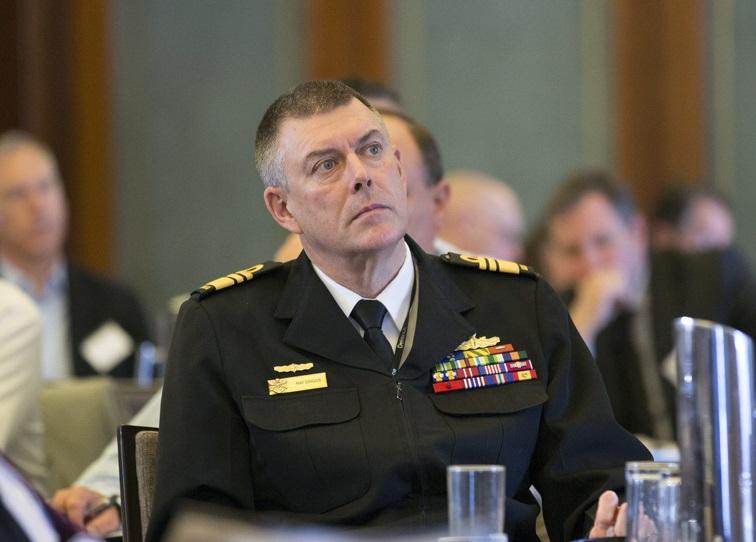Talking to the chiefs: Ray Griggs (part 2)
Posted By Brendan Nicholson on June 5, 2017 @ 11:00
For the ADF to be a war winning force it must be fully integrated and accepting of cultural and gender differences, says Defence’s Vice Chief, Ray Griggs.
Vice Admiral Griggs tells The Strategist the transformation in attitudes he’s seen since joining the ADF as a 17 year old recruit reservist in Adelaide in 1978 is dramatic. ‘It’s night and day.’
He says the key to completing the process is to convince the community that the inclusion debate is about capability. ‘We fight in teams whether it’s a ship, a battalion or a squadron. You can’t be effective if everyone in that team is not respected and trusted. It’s as simple as that.’
Griggs strongly rejects criticism of the ADF’s push to recruit and support personnel from all of Australia’s cultures. ‘We’ve been copping it over what we’re trying to do in the area of culture and inclusion. In the early 2000s we were being belted up for being non-inclusive and having a poor culture and we’ve put a lot of effort into improving our culture.
‘If your organisation is not diverse, how can you be better than the other side? I think that message gets lost so you get charged with being involved in identity politics, or embarking on some politically correct campaign, or with having an ADF that’s ‘got soft’, says Griggs. He says the ADF is definitely not soft. ‘It’s a very, very professional force that is incredible well equipped, has great people and is well trained.’
Like every organisation, the ADF faces a big challenge in the nation’s changing demographics and it can’t continue to recruit from just its traditional base with a smaller pool of people at traditional recruiting age. ‘We have to be able to tap the talent across the country and not shut segments of that population off just because they don’t look or sound like a stereotypical view of what your demographic base is.
Indigenous recruitment is increasing steadily.
‘We have around 600,000 Muslims in Australia and we need to tap into that talent as much as in any other part of the population. That gets us into all sorts of difficult territory but the reality is we’re trying to put on the park the best ADF this country can offer and the only way to do that is to tap into the talent across all parts of society.
‘Team cohesion is crucial to us fighting and winning. We are deadly serious about it. We’ve got to fight and win.’
Diversity also makes it easier for the ADF to operate in culturally sensitive areas, says Griggs. ‘If your force is culturally diverse and inclusive in its nature, you’re inherently better prepared to do operations in different parts of the world where understanding those sensitivities becomes second nature to you because you understand them in your own workplace.’
When Griggs joined the Navy it was a crime to be gay in the services and he recalls a colleague who thought he was going to be outed and killed himself. ‘We’ve done a pretty good job on gender though we’ve still got a way to go. We’ve done very well in terms of the LGBT population.’
The Defence Abuse Response Task Force exposed what Griggs describes as ‘some pretty awful stuff’ occurring over five decades and Defence leaders were particularly concerned that some of it was contemporary. ‘That has really sharpened our focus on cultural reform.’
He, like other senior officers, spent time with abuse victims. He took part in about a dozen ‘restorative engagement’ sessions, listening to the stories of abuse victims. ‘You can’t have those interactions with people and not be affected by it and not see the human cost of what abuse did to them.’
Griggs says the task force report was incredibly difficult to read. ‘It’s been hard to listen to these stories and see the pain in these people’s eyes and the impact it’s had throughout their lives. ‘It was once a very rough and tough culture. I think the culture has improved massively. You can’t fight and win in a team unless you trust and respect each other. That’s what this is all about.’
While recruitment and retention rates are strong, a related challenge is to find people with the skills to run complex new equipment. ‘Enough people are joining the forces. An open question is whether we have enough with the skill sets we need.’ Griggs says that’s the same for any organisation with a high technology base. ‘One of our biggest national challenges, not just in Defence, is the issue of STEM and how we attract young people to technical, scientific, engineering, maths related careers.
‘We run our own programs but we’ve still got to have an outflow from the education system of kids who have interest, aptitude and competence in those areas. We’re going to get more sophisticated and more technical. But I don’t doubt we can find the people we need.’
The ADF looks 10 to 15 years ahead and he’s confident the Navy will find crews for its 12 new submarines. ‘We’ve shown over the last five or six years that we can grow the submarine arm. It’s not like we need the crews tomorrow. We’ll be building these things into the 2040s.’
Griggs notes that five of the Navy’s six Collins-class submarines are now at sea or ready for sea. ‘I remember rejoicing when we had three at sea. It shows what you can do with an enormous amount of hard work, effort and focus.’ Success breeds success, he says, and the Collins is now an exceptional boat. Six years ago morale in the submarine arm was pretty ordinary.
‘Now it’s completely turned around with crews deployed and doing interesting work.’
Article printed from The Strategist: https://aspistrategist.ru
URL to article: /talking-chiefs-ray-griggs-part-2/
Click here to print.
